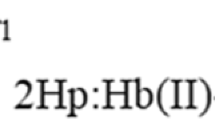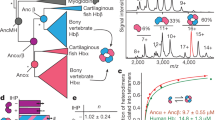Abstract
HAEMOGLOBIN (Hb) M Boston and Hb M Iwate, in which distal and proximal histidines, respectively, in the haem pockets of α chains are replaced by tyrosines, bind ligands only to the normal β chains, and have α chains stabilised in the ferric form. These M Hbs contain mutant α chains and have abnormally low oxygen affinity, almost no Bohr effect and virtually no haem–haem interaction1,2. The β chain mutants, Hb M Hyde Park and M Saskatoon, have normal oxygen affinity and a normal Bohr effect but show almost no haem–haem interaction3,4. Thus among the M Hbs, the proximal and distal mutants of the same chain display similar ligand binding properties. When abnormal α chains of Hb M Iwate are completely reduced using dithionite, the affinity for CO and Bohr effect were almost normal, but Hill's constant was still one1. It has been suggested that the ligand binding properties of completely reduced Hb M Boston are approximately the same as those of Hb M Iwate5,6. We have studied the equilibria of Hb M Boston and Hb M Iwate in both the half ferric and completely reduced states using ethylisocyanide (EIC), a non-oxidising ligand which equilibrates rapidly with haemoglobin, and here report that the completely reduced Hb M Boston shows ligand binding properties similar to those of Hb A.
This is a preview of subscription content, access via your institution
Access options
Subscribe to this journal
Receive 51 print issues and online access
$199.00 per year
only $3.90 per issue
Buy this article
- Purchase on Springer Link
- Instant access to full article PDF
Prices may be subject to local taxes which are calculated during checkout
Similar content being viewed by others
References
Hayashi, N., Motokawa, Y., and Kikuchi, G., J. biol. Chem., 241, 79–84 (1966).
Suzuki, T., Hayashi, A., Yamamura, Y., Enoki, Y., and Tyuma, I., Biochem. biophys. Res. Commun., 19, 691–695 (1965).
Ranney, H. M., Nagel, R. L., Heller, P., and Udem, L., Biochim. biophys. Acta, 160, 112–115 (1968).
Suzuki, T., Hayashi, A., Shimuzu, A., and Yamamura, Y., Biochim. biophys. Acta, 127, 280–282 (1966).
Pulsinelli, P. D., Perutz, M. F., and Nagel, R. L., Proc. natn. Acad. Sci. U.S.A., 70, 3870–3874 (1973).
Greer, J., J. molec. Biol., 59, 107–126 (1971).
Anderson, N. M., Antonini, E., Brunori, M., and Wyman, J., J. molec. Biol., 47, 205–213 (1970).
Author information
Authors and Affiliations
Rights and permissions
About this article
Cite this article
NISHIKURA, K., SUGITA, Y., NAGAI, M. et al. High cooperativity of haemoglobin M Boston in the completely reduced state. Nature 254, 727–728 (1975). https://doi.org/10.1038/254727a0
Received:
Issue Date:
DOI: https://doi.org/10.1038/254727a0
This article is cited by
-
Differences in coordination states of substituted tyrosine residues and quaternary structures among hemoglobin M probed by resonance Raman spectroscopy
JBIC Journal of Biological Inorganic Chemistry (2010)
-
Evolution of the haem-haem interaction in vertebrate haemoglobins - a hypothesis
Journal of Molecular Evolution (1975)
Comments
By submitting a comment you agree to abide by our Terms and Community Guidelines. If you find something abusive or that does not comply with our terms or guidelines please flag it as inappropriate.



